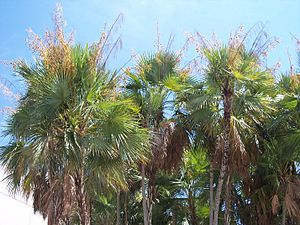Acoelorrhaphe facts for kids
Quick facts for kids Acoelorrhaphe |
|
|---|---|
 |
|
| Stand of fruiting specimens | |
| Scientific classification | |
| Genus: |
Acoelorrhaphe
|
| Species: |
wrightii
|
| Synonyms | |
|
|
The Acoelorrhaphe is a type of palm. It has only one species called Acoelorrhaphe wrightii. You might know it better by its common names like the Paurotis palm, Everglades palm, or Madeira palm. In Spanish, people call it cubas, tique, or papta.
This palm tree grows naturally in Central America, southeastern Mexico, the Caribbean, Colombia, the Bahamas, and the very southern part of Florida. It loves to grow in swamps and forests that get flooded sometimes.
It's a small to medium-sized palm that usually grows in groups. It can reach about 5 to 7 meters (16 to 23 feet) tall, but sometimes even 9 meters (30 feet). Its thin stems are less than 15 centimeters (6 inches) wide.
The leaves look like a fan, which is called palmate. Their parts are joined together for about half their length. They are about 1 to 2 meters (3 to 6.5 feet) wide. The top of the leaves is light green, and the bottom is silvery. The leaf stems, called petioles, are about 1 to 1.2 meters (3 to 4 feet) long. They have sharp, orange, curved teeth along their edges.
The flowers are tiny, hard to see, and greenish. They have 6 stamens, which are the parts that produce pollen. The tree's trunk is covered with a fibrous, mat-like material. The fruit is small, about the size of a pea. It starts out orange and turns black when it's ripe.
The name of the genus, Acoelorrhaphe, comes from three Greek words. A- means 'without', koilos means 'hollow', and rhaphis means 'needle'. This name describes the shape of the fruit. The species is named after an American botanist named Charles Wright.
Growing and Using the Paurotis Palm
The Paurotis palm used to be very common in the Florida Everglades. However, many plants were taken from the wild to be sold in plant nurseries. Because of this, the palm is now protected by Florida law. This means its numbers are starting to grow again in the wild.
You can find these trees in nurseries today. They are grown from seeds or by carefully splitting apart the base of a palm cluster. The Paurotis palm can grow well in central and southern Florida. People often plant it in their yards and gardens as a beautiful landscape palm.
Gallery
Images for kids
See also
 In Spanish: Acoelorraphe wrightii para niños
In Spanish: Acoelorraphe wrightii para niños




